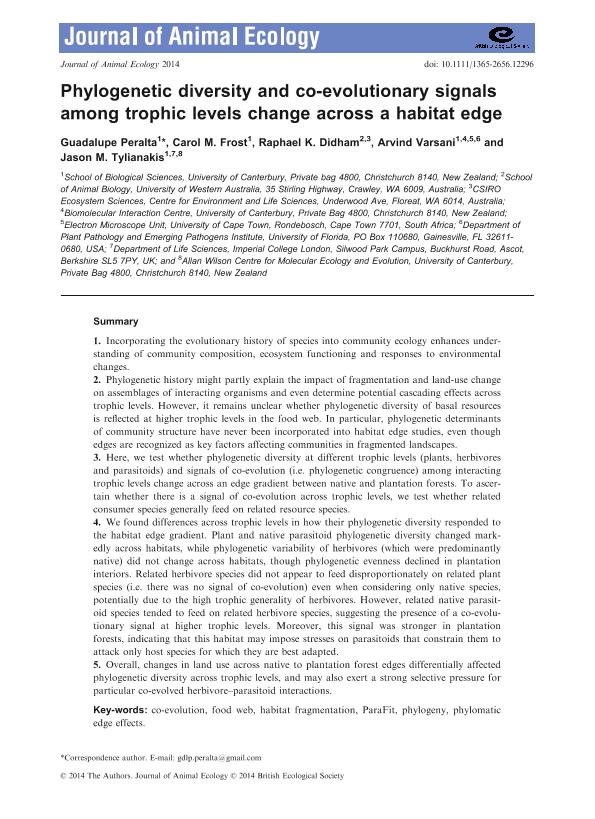Artículo
Phylogenetic diversity and coevolutionary signals among trophic levels change across a habitat edge gradient
Fecha de publicación:
10/2015
Editorial:
Wiley Blackwell Publishing, Inc
Revista:
Journal Of Animal Ecology
ISSN:
0021-8790
Idioma:
Inglés
Tipo de recurso:
Artículo publicado
Clasificación temática:
Resumen
1. Incorporating the evolutionary history of species into community ecology enhances understanding of community composition, ecosystem functioning and responses to environmental changes. 2. Phylogenetic history might partly explain the impact of fragmentation and land-use change on assemblages of interacting organisms, and even determine potential cascading effects across trophic levels. However, it remains unclear whether phylogenetic diversity of basal resources is reflected at higher trophic levels in the food web. In particular, phylogenetic determinants of community structure have never been incorporated into habitat edge studies, even though edges are recognised as key factors affecting communities in fragmented landscapes. 3. Here we test whether phylogenetic diversity at different trophic levels (plants, herbivores, parasitoids) and signals of coevolution (i.e. phylogenetic congruence) among interacting trophic levels change across an edge gradient between native and plantation forests. To ascertain whether there is a signal of coevolution across trophic levels, we test whether related consumer species generally feed on related resource species. 4. We found differences across trophic levels in how their phylogenetic diversity responded to the habitat edge gradient. Plant and native parasitoid phylogenetic diversity changed markedly across habitats, while phylogenetic variability of herbivores (which were predominantly native) did not change across habitats, though phylogenetic evenness declined in plantation interiors. Related herbivore species did not appear to feed disproportionately on related plant species (i.e. there was no signal of coevolution) even when considering only native species, potentially due to the high trophic generality of herbivores. However, related native parasitoid species tended to feed on related herbivore species, suggesting the presence of a coevolutionary signal at higher trophic levels. Moreover, this signal was stronger in plantation forests, indicating that this habitat may impose stresses on parasitoids that constrain them to attack only host species for which they are best adapted. 5. Overall, changes in land use across native to plantation forest edges differentially affected phylogenetic diversity across trophic levels, and may also exert a strong selective pressure for particular coevolved herbivore-parasitoid interactions.
Archivos asociados
Licencia
Identificadores
Colecciones
Articulos(IADIZA)
Articulos de INST. ARG DE INVEST. DE LAS ZONAS ARIDAS
Articulos de INST. ARG DE INVEST. DE LAS ZONAS ARIDAS
Citación
Peralta, Guadalupe; Frost, Carol; Didham, Raphael; Varsani, Arvind; Tylianakis, Jason; Phylogenetic diversity and coevolutionary signals among trophic levels change across a habitat edge gradient; Wiley Blackwell Publishing, Inc; Journal Of Animal Ecology; 84; 2; 10-2015; 1-9
Compartir
Altmétricas




